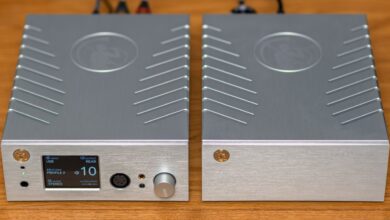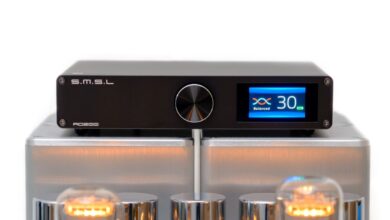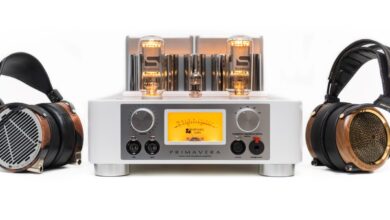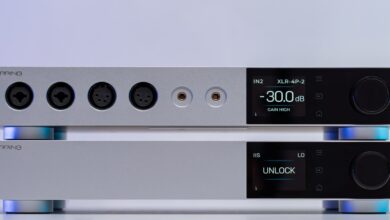Topping A90 Discrete Review – Forging Ahead
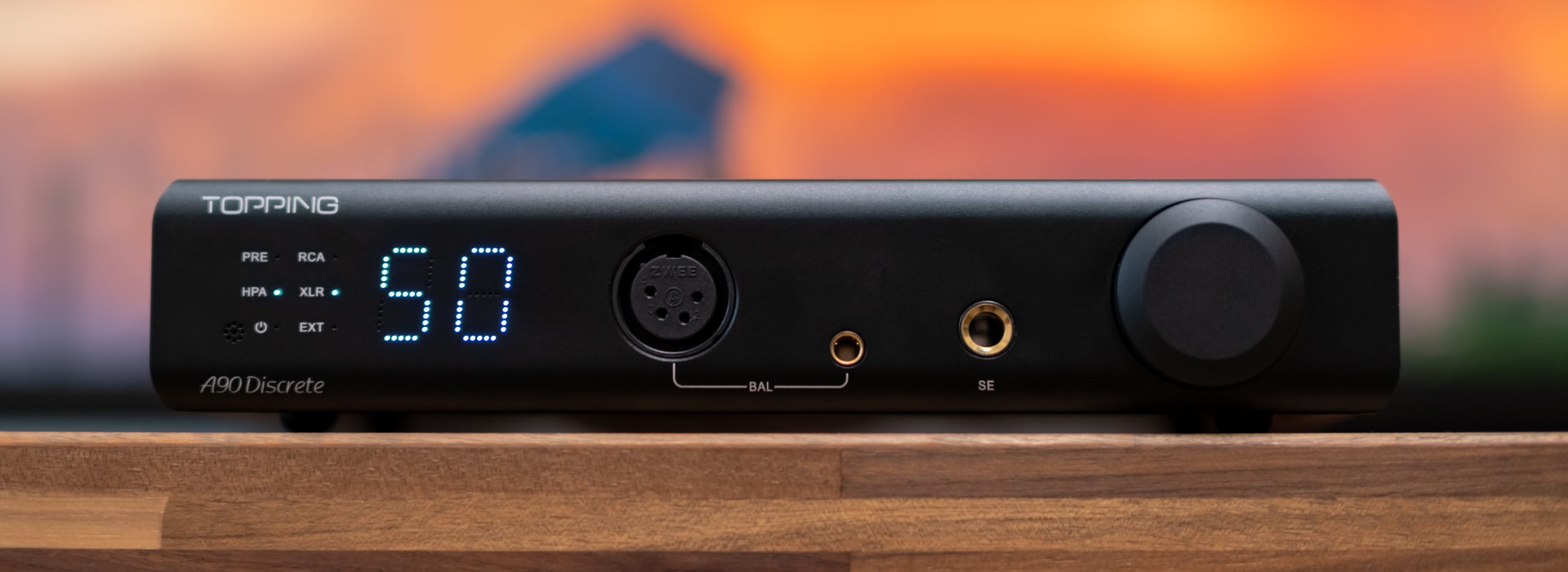
My Video Review:
Looking closer at the head-fi market, I counted three big waves when it comes to amplifier designs. The first wave came somewhere in ~2018, when THX announced their Achromatic Audio Amplifier modules (THX-AAA for short), that revolutionized the headphone amplifier market as we know it. Suddenly, great measuring and good sounding amps were no longer unobtanium material and people could genuinely afford such units that wouldn’t add colorations and distortions into the mix. Several brands started licensing such modules overnight, even the Pro Audio world switched gears as brands as Mytek Digital and Benchmark Media started working on high-end headphone amps carrying such technology and you already spotted a Benchmark HPA4 in a lot of reviews around here. The second wave came when brands as SMSL, Topping and others challenged themselves in releasing even better measuring modules and you already saw plenty of PLFC (Precise Linear Feedback Circuit) and NFCA (Nested Feedback Composite Amplifier) headphone amps around here. I think we’ve tested the biggest majority, if not all of them. When Topping A90 arrived at our HQ, it put our jaws on the floor as it sounded very similar to a Benchmark HPA4 at a sixth of its price, which was inconceivable at that time. Obviously, Topping needed to cut some corners arriving at such an affordable price point, as A90 lacked a display, a precise relay-based volume control and a solid I/O. Nonetheless, it sounded great from day one and I was recommending it left and right for at least a year or two.
However, when great sonics and fun factor are becoming more important than mere measurements appearing on a screen, op-amp based amplifiers will be slowly disappearing from the landscape, as you’ll never see them in high-end audio applications, only units that carry discrete components. From an army of solid-state headphone amps, the highest-ranking units were still the Flux Labs Acoustics Volot, Ferrum Audio OOR, Burson Audio Soloist 3X GT and the Enleum AMP-23R which are being powered by discrete components. With such units there is always a sense of effortlessness and unrestrained power, as if listening to unamplified music as discrete components aren’t limiting dynamics and power flow as op-amps are doing in entry to mid-level designs. After getting to know the A90, a few months later Singxer proved that all-discrete amps can still be had even below the $1000 mark, as their SA-1 performed exemplary at $599. Roses were red and violets were blue for a while, but there was still a single problem with SA-1 and that was: output power. It was enough for most desktop headphones especially for dynamic-driver ones, but clearly…not a lot of power was flowing through its veins as several planar-magnetic headphones as Hifiman Susvara and Abyss AB-1266 were running out of steam.
Sneaky as they are, Topping engineers were taking notes, already experimenting with next generation amplifier modules behind closed doors. I knew that something different was cooking under my nose, but Topping refused to reveal their cards. A year later, their next generation TOTL amplifier was finally revealed, calling itself A90 Discrete. There were several things that I didn’t like about the original A90, but with the newest unit, it seems that everything was reworked from the ground up and the only thing that remained intact was its name and machined aluminum case. Limited op-amps were no longer staying in the signal path, swapping them with hundreds of discrete components and there’s a much higher precision relay-based volume control as well. A90 Discrete isn’t only a direct replacement to the aging A90, but also a Topping PRE90 killer, as in some ways I find it better than their dedicated preamplifier released just a few months ago. A90 Discrete caters not only to the head-fi market, as an included remote control and a precise volume control makes it an exemplary candidate for a great preamp in a stereo setup.
There is so much more about the A90 Discrete, which I will be writing about shortly. It goes for 599$ in the USA, which is only by $100 costlier to the original A90 and the final question remains the same: will it deliver an amazing performance in both a stereo and head-fi setup and will it earn its place as my daily-driver headphone amp for years to come? Let’s find that out together.

Unboxing Experience
If it ain’t broke, don’t fix it and that’s exactly what Topping did with the packaging. I am getting a familiar sight with a matte-black card-board box that houses the unit and all its accessories. Everything came double boxed and that’s already a common practice in the world of Hi-Fi. Besides wrapping everything with absurd amounts of black foam as an extra protection measure, you’ll find the unit itself, a headphone adapter, a power cable and a small surprise: a RC-16A Topping branded remote control. It is cheaply made and nothing is too fancy about it, but it works as intended. It’s made out of matte plastic with rubberized buttons, which lets you select a desired input, output and volume level.
In the usual fashion, there’s a warranty card that doubles as a product catalogue and a user manual that doubles as measurements analysis. Starting with Signal-to-Noise ratio and finishing with Total-Harmonic-Distortion, everything can be found in the manual and I wish amplifier makers would take notes and deliver a similar experience. So far so good, I have nothing to complain. I’m pleased the most about the included remote control, which will be helping me tremendously in a stereo setup.

Design & Build Quality
I see that Topping are slowly moving towards their 3.0 case design with units like DX5 and DX7 PRO+ that were reviewed weeks ago, but it seems that their flagship devices as D90SE and A90 Discrete are still using the same, good old machined aluminum cases. I personally like the understated look of A90D and D90SE a little bit more, looking like solid unibody devices with their aluminum brick like cases. A90 Discrete is following the same design cues, form factor and dimensions of its older A90 sibling and for me that’s a plus. There are small changes here and there, but we are still looking at a simple unit made for minimalists.
There are no longer heavy-duty analog switches on its front panel, making it sleeker and more elegant in a way. You can still choose a desired analog input and output single-handedly via single or double presses on its volume knob and for the first time in Topping’s portfolio, there’s a mini-LED display that will show you an exact volume level. Since there are 99 steps available, you’ll be informed in advance if you’re approaching its upper power limits with low-sensitivity headphones. Although we are getting a much nicer stepped volume attenuator, I slightly dislike that there is still little to no resistance when turning its wheel.
You can have it in matte black or matte silver and at about 1.25 kilos or 2.75 pounds, it’s neither too heavy or lightweight. I find it small and compact enough to be used in crowded headphone or stereo setups and if you already own one of their DACs, maybe it would be wiser stacking them with a newly released SR2 aluminum rack, which adds a high-end flair to the whole affair.

Controls & I/O
A90D is so far the cleanest looking headphone amplifier of Topping. On its front panel you’ll find a volume wheel, two balanced headphone jacks (4-pin XLR and 4.4mm) and a regular 6.35mm headphone jack. Several low-intensity LEDs will be showing its volume position, selected input and output and everything else was moved to its back.
It has single ended RCA and balanced XLR inputs and a mirrored symmetry of analog outputs, since it can work as a preamp if you need it. There’s a 12V trigger – just in case you’ll want to power all your devices with a singular remote. There’s a ground / lift switch that should solve potential issues with ground loops and there’s an additional EXT input borrowed from PRE90 that lets you connect it to EXT90 for additional analog inputs.

Under the hood of A90 Discrete
As its name suggests, Topping moved away from limited op-amps and developed newer headphone amplifier modules from discrete components (as transistors and diodes), calling them NFCA Discrete modules. These modules are considerably bigger, as there are hundreds of components in each module, generating and dissipating more heat in the process. You can spot four mono modules, meaning that A90D is indeed a fully balanced input to output amplifier and preamplifier. 39 transistors have been used per module, combined with a more robust power supply, A90D upped the ante in terms of power output, as from 7.6 Watts per channel on A90, we are getting a much stronger output of 9.8 Watts, almost ~10 Watts per channel in 16 Ohms, which seems like a lot considering its tiny size. At higher impedance numbers both A90 and A90D are looking pretty much the same, delivering a single Watt in 300 Ohms, suggesting that A90D can deliver a similar voltage at a higher impedance and a higher current at a lower impedance for hungry planar-magnetic headphones.
We are no longer getting an oversimplified analog volume pot, but a higher-precision R-2R control that uses ladders of resistors and analog relays for a perfect channel balance, regardless of the volume level.
When used as a preamplifier, A90D is equally impressive, accepting much hotter signals of 9.1 Vrms via high-gain and it can output up to 49Vpp, which looks more than enough for most power amplifiers. It provides a very low output impedance of 20 Ohms via RCA and 40 Ohms via XLR, ensuring an excellent damping factor for the amplifier that follows. In traditional Topping fashion, regardless of its working mode (headamp or preamp), A90D will keep an ultra-low noise floor for the highest possible Signal-to-Noise ratio (SNR). While A90D is filled with discrete components, its measurements were kept under a strict control and if the number game is important to you, then A90D is one of the best measuring headphone amp and preamp on the market right now.
Test Equipment
Topping’s A90 Discrete was mostly used in a reference headphone setup, but I also tried it as a preamp in a stereo setup. In my office it was connected to a Chord Electronics Dave, driving all sorts of desktop headphones, ranging from affordable to high-end cans. I’ve tested its noise floor with ultra-sensitive IEMs and with my KEF Reference 3 speakers as well.
In a stereo setup, it was connected to Chord Electronics Dave, followed by A90D working as a pre and by a Chord Electronics Ultima 5 power amplifier, so I could better feel its tonality and preamp functionality.
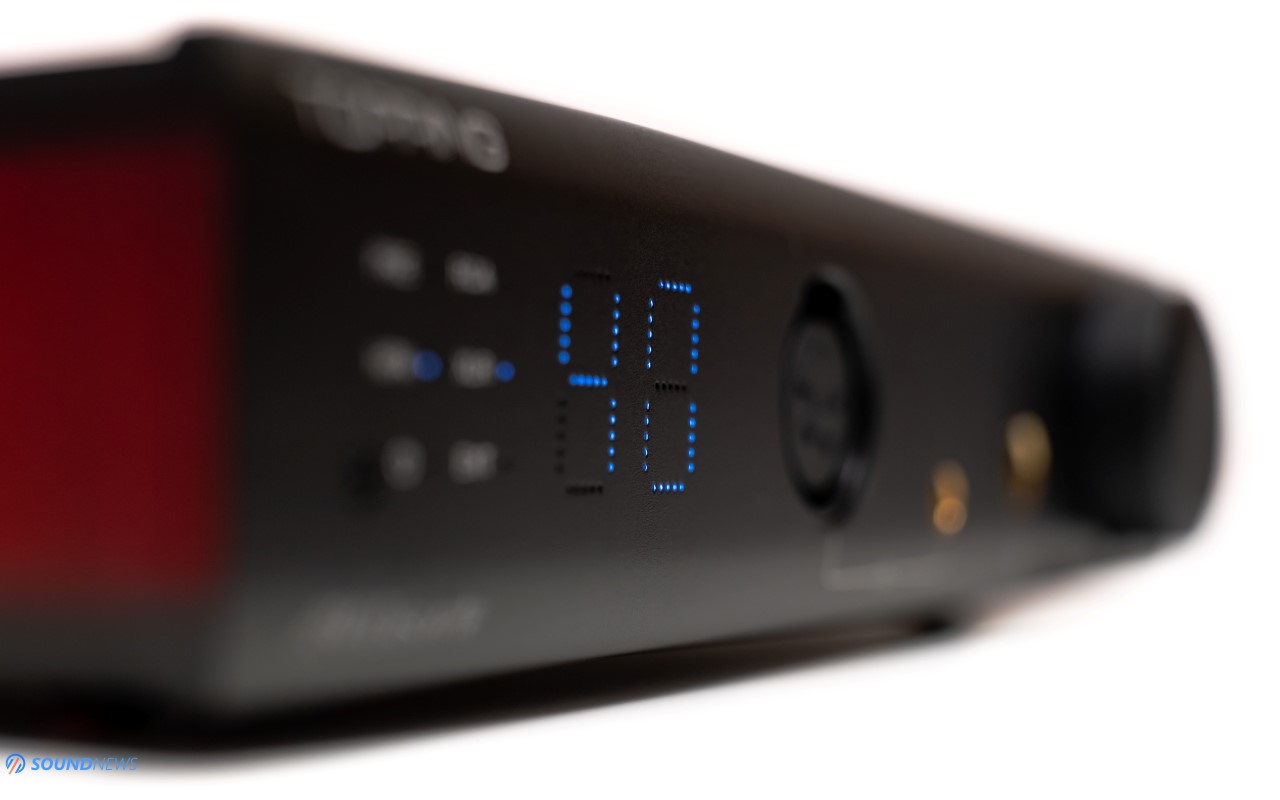
Sound Performance.
I. Preliminary Impressions
Some things will probably never change when it comes to Topping and their gizmos and by that, I mean their legendary detail retrieval and transparency levels. As it was the case with previous NFCA-based amplifiers, A90D revealed itself as detail retrieval incarnate, trying to bring as much information to the surface even from less than perfect recordings. Everything was popping all around me, everything felt defined and contoured, without becoming edgy or claustrophobic. While I could describe the original A90 as sharp sounding with a few particular D/A converters and musical genres, A90D goes with a different philosophy trying to be ultra-clean, but without becoming overly sharp or edgy sounding. The OG A90 was going south to what I would describe as ultra-linear, as I found it by a hair warmer, smoother and more organic sounding versus THX-AAA based amplifiers and it seems that Topping tuned their A90D differently, going with smoother leading edges and denser textures. It shouldn’t come as a surprise as we are finally dealing with a fully-discrete amplifier that’s no longer limited by op-amps in any way. There is a higher current delivery with low and mid impedance headphones and you can feel that immediately, as the sound flows much easier this time around. A90 wasn’t straining my ears and I found it easy to pair with a lot of headphones, but it seems that Topping pushed that concept further, delivering a higher saturation in the bass and midrange, while relaxing the treble delivery by a little, for a more natural rendition of treble intensive tracks. While A90D won’t challenge the best headphone amps ever made when it comes to engagement factor, it will easily challenge and maybe surpass most amplifier below one grand.
A higher current output left a big mark when heavy hitters as Hifiman Susvara, Audeze LCD-4 and LCD-5 started playing, as the sound became thicker and faster at the same time. Quick shifts in dynamics were nicely rendered, getting a better transient response versus its older brother. While the original A90 was moving extremely fast, it was shier when trying to deliver impactful bass notes. In this regard, A90D is by a hair more energetic sounding down low, adding more energy to the lowest octaves that are so important with electronica tunes. Everything that was passable with Hifiman Susvara on the OG A90, improved by a notch on the newest unit, especially when it comes to dynamics. I still don’t recommend using heavy loads as Susvara or AB-1266 Phi TC with either A90 variants, but the newest unit definitely sounded denser and fuller bodied. I’m not just about the low-end delivery, but about the whole frequency response which felt richer. Some people were calling the original A90 as cold and sterile sounding and while I would never describe it that way, I understand why not everybody enjoyed the ultra-linear tonality of A90. This time around, a fully discrete circuitry added more richness and a denser overall tonality. While A90D still measures dead flat on a APx555 Audio Analyzer, my ears were telling me that there’s a definitive change when rendering bass, midrange and treble information. It’s no longer tilted towards a strong treble delivery, I felt it calmer in that region, punchier and fuller-bodied at the other end of the spectrum (sub-bass).
For what it’s worth, Topping took their best ultra-linear sounding headamp and planted more life in it. Yes, there’s a nicer and a sweeter midrange delivery, a better mid-bass rendition and a gentler pre and post-ringing in the treble. From a dead-flat to a point of being boring sounding, A90D delivers a different message, catering not only to the measurements crowd, but to music lovers as well that don’t care much for the numbers, as they care for emotions, goose bumps and air guitars alone.

II. Detail Retrieval
Let’s deal with the obvious parts and then move to things that weren’t that impressive. Here’s the thing: even without any kind of burn-in, after just a minute of music playback there was something that stood above everything else and that my friends is detail retrieval. An absurd amount of information will be constantly coming towards you. Want it or not, A90D will be putting on a pedestal all the good and all the bad your music has to offer. Living with ultra-clean sounding amplifiers for a few years now, I appreciate when an amplifier is trying to give me more, rather than hiding bits of information. There’s a reason I purchased a Benchmark HPA4 headamp and two Benchmark AHB2 power amps, for the same reason I bought the Enleum AMP-23R, Chord Dave and Ultima 5 and there’s a reason my very first video over YouTube was posted in 4K DCI. I like resolution and I cannot live without it. If you want the highest resolution per buck in form of a headphone amplifier or preamplifier, then A90D seems like your best option right now.
Simply put, every sound I was hearing on the Enleum AMP-23R $6400 was popping around me when A90D started playing. While I’m no longer chasing the absolute best measurements out there (a thing of the past for my journey), a few numbers like dynamic range and noise floor are still important when trying to preserve information and deliver the cleanest possible signal. With crazy numbers like 145 dB signal-to-noise ratio and with an inaudible noise floor of 1.8 uV (at its worst), you will never experience any kind of distortion, not even at its highest volume position. Noise and distortion are nowhere to be found and the only thing that remained is the unspoiled truth. While audio analyzers can’t measure all and everything, they can measure resolution and dynamic range and it seems that A90D has one of the highest dynamic ranges ever recorded on a headamp.
I no longer went through all the stages of Kubler-Ross curve of change as I did with A90, as I was expecting a clean sounding unit and it didn’t disappoint a single bit. If resolution is your thing and you like hearing all that is hiding behind your tracks, then A90D is a very easy recommendation to make. There is a small change versus the original A90, as the newest unit exactly as clean and detailed, but I no longer find that slight treble itch when listening via linear sounding headphones as Hifiman HE1000SE, Susvara or Sennheiser HD800S.

III. Noise Floor
When Topping created their own NFCA modules a few years ago, they wanted the maximum amount of power and the lowest levels of noise at reasonable prices. All their NFCA powered amplifiers hit the jackpot, even their affordable units were fighting the noise so ferociously, that I never heard traces of noise even on their L30 and L50 amplifiers.
On paper discrete amplifiers should be noisier and they usually are, mostly because several op-amps are replaced with hundreds of components that are generating more noise and are lowering the channel crosstalk. Topping did one clever thing, that a lot of companies didn’t do: they sealed all those components in think aluminum capsules. An open circuit will generate noise and crosstalk if crucial components are staying in their vicinity to and that’s why high-end DAC and amplifier makers are encapsulating their output stages and amp modules. Topping went with a similar idea, further lowering the noise and again, increasing the dynamic range. At worst, A90D will provide a noise floor of 1.8 uV and at best just 0.2 uV levels of noise, which is sincerely a world-class performance regardless of price.
No matter what portable headphones or IEMs you will be using with Topping made amplifiers, they will sound noiseless regardless of the selected gain or volume position. With A90D, you can forget about hiss or nasty gremlins as there’s only music playing in the background and nothing more. On high gain and at normal listening levels, you can use the highest sensitivity IEMs and you’ll never hear disturbing noises, making it an extremely IEM friendly amplifier. Volume wise, the highest I could go was about 12 O’clock on low-gain or about 9 O’clock on the high-gain and if you want to have a total control with your IEMs, use low gain for the best results.

IV. Transient Response
While A90D might fly like a butterfly with acoustic music, it stings like a bee with rock and electronica music and that was apparent just after a few hours of burn-in. There aren’t linear transformers inside its case, fat capacitors aren’t dwelling in there, meaning that a few hours are more than enough to unleash its fullest potential. Original gangster A90 was already a fast-sounding amp, always challenging my headphones, my tunes and my hearing abilities, delivering a good…but not so great impact into my eardrums. I find A90D exactly as fast, but this time around there is a higher impact with electronica tunes, making it wilder, satisfying my requirements when listening to such genres. I can’t stand mellow and slow sounding amplifiers, especially if the music commands a different pace. If my blood isn’t boiling with fast tunes, I will probably move on and try a different amp. When called for, I want my tunes mean and impactful, while with slow and relaxing tune, I want a calmer and a slower pace. Sadly, not all amplifiers can do that.
Every amp can be slow and mellow with relaxing tunes, but not all of them are flexing their muscles delivering higher dynamics and a faster pace. When Topping replaced limited op-amps with hundreds of transistors, the bandwidth widened, current delivery improved and of course the low-end is flowing much easier. The sound feels more energetic than before, putting a higher accent on fun factor. In high-end audio everything is about resolution and timing, miss a single note you messed everything. By design, amplifiers need to be fast and nimble, otherwise you can forget about a clear imaging, about defined contours or precise location of the notes. While A90D won’t outperform the craziest sounding solid-state amplifiers that passed through my hands, at less than a grand A90D becomes the strongest candidate for a wild and impactful amp without staying in the way of the music. I can finally describe a Topping made amp as…impactful and punchy sounding with the right music and headphones. So far, this is the punchiest sounding amplifier I have experienced at $599, it was masterfully done.

V. Soundstage & Imaging
Armed with some of the widest and deepest sounding headphones, I went through several live albums for just to know it better when it comes to spatiality. The layering was spot on, sounds were sometimes coming from behind my back and some tunes are still going outside my head playing at an arm’s reach. All signs were pointing towards a pretty good soundstage that wouldn’t limit the nature of open-back headphones. While being engaging, quite bassy and mid-centric, Apos Caspian still had that on-stage presentation, never putting too much information to my left and right. Sennheiser HD800S played my tunes quite differently, putting a lot of information to my sides and a lot less in the middle, that worked as magic with old mono recordings.
The only area that felt moderately improved versus its predecessor is definitely the soundstage. A higher power output will push dynamics further and a higher current delivery will have a beneficial effect when controlling headphone drivers at higher speeds, but it seems that the stage size didn’t increase that much and didn’t envelop my entire body. Out of all Topping headphone amps, A30 PRO was one of the airiest sounding ones and it seems that A90D outperforms it by a little, delivering a deeper presentation.
A90D won’t challenge the absolute rulers of the soundstage kingdom as Flux Lab Acoustics Volot, Enleum AMP-23R, Trafomatic Head 2 and Trafomatic Primavera, but at the same time we are talking about a tiny amp that that tries to sound big, without cost you an arm and a leg. With tracks like Black Horse And The Cherry Tree by KT Tunstall (Qobuz / Tidal), a myriad of sounds were landing all around me, leaving the center stage for the vocal performance. This tune is presented in a pointlessly extended mix that adds fat to the central whistling melody at the expense of a faster tempo. A near-perfect folk-rock tune that moved backing vocals much deeper into the mix, never inter-playing with the lead singer, improving the perception of space and distance in between the notes. I enjoyed the left to right interplay, as several instruments were switching places. The guitars were sometimes closer to my left and sometimes farther to my right and it seems that A90D was easily portraying that information. This tune brought a lot of air, just add an open-back headphone and you could almost forget that you’re using headphones in the first place. Shooting Stars by Rival Sons (Qobuz / Tidal) left even a deeper impression as the backing vocals felt so deep, as if someone was sitting in the room with me singing in my close vicinity. Bass guitar was easily piercing the veil, sounding so clean and defined in such a crowded tune. I didn’t experience a bigger than life soundstage and depth, but it was definitely bigger to any other Topping, SMSL or Gustard amplifiers I tried so far. Defined leading edges and an exact timing left a positive mark, as with my eyes closed, I was immediately transported into a live concert. While never sharp to a point of becoming bothersome, A90D rendered this track with utmost accuracy, adding a layer of ease and refinement that was missing on its older brother.

VI. Power Output
Being one of the most powerful headphone amps at this price and size has its perks, as you can drive pretty much everything that has a headphone plug. You can include notorious low-sensitivity headphones as Hifiman Susvara, Abyss AB-1266 and Audeze LCD-4 to this list. There wasn’t a headphone that was limping or mildly pressing the brakes with fast & impactful tunes. Be it planar-magnetic or dynamic driver headphone, A90D was able to drive them all with a substantial amount of headroom remaining on tap.
As you can guess, there was an amazing driver control and I never felt that it was skipping a few notes with electronica tracks. Dynamics were jumpy and after a few tracks, I started moving my head up and down, a clear sign that it knows how to impress a music addict.
With high impedance headphones as Sennheiser HD800S (300 Ohms) or Audeze LCD-4 (200 Ohms), there wasn’t a clear difference in between the regular A90 and A90D, as I’m getting a similar SPL. When I moved to low-impedance headphones, in several cases high-gain would be too much on A90D, especially with something like Erzetich Phobos V2021 and Kennerton Rognir planar. I needed to crank the volume a little higher on the regular A90 for a similar SPL and I could feel in my gut that A90D is punchier and meaner sounding with such headphones.
I’ve got a pleasant surprise when I connected the Hifiman Susvara to it, which worked just Okay from the regular A90, but far from being a great match. At 60 Ohms and at a sensitivity of 83 dB per 1mW, Susvara is harder to drive than my own 55 kilo-a-piece standfloor loudspeakers as they certainly love juicy watts flowing through their drivers. I never reached max power on A90D, something that was constantly happening via the regular A90. What’s more interesting is that Susvara weren’t dead on arrival and I found them quite enjoyable, pushing bass notes as if a beefier amplifier was driving them. While far from optimum performance, A90D didn’t botch dynamics and didn’t limit the air travel, never making them tiny sounding. My former Benchmark HPA4 was making them too up-front, with little to no low-end delivery, something that wasn’t happening with the A90D. Discrete components were sustaining longer bass notes without lowering their intensity and that was felt when organ pipes made their presence felt. I could easily live with the A90D and Susvara with regular tunes, but on several occasions, I was reaching to higher tiered and higher-powered amplifiers that could bring better dynamics.
Nonetheless…the little one impressed the hell out of me, providing plenty of power, nicely controlling the drivers of dynamic and planar headphones alike, making order in the frequency response while adding more life and fun to a previously dead-flat sounding amp.

VII. Frequency Response
While still linear and straight as a line, it does several things differently versus its older sibling. Let’s start with the obvious parts.
A. Bass
A90D delivered a clean, detailed and distortionless bass output, there’s more oomph and you can feel that the air is heavier to breathe, having more music and less empty spaces. The bass region was fuller and punchier, especially in the mid-bass region. Both units are pretty similar when it comes to sub-bass rendition, reaching 20 Hz notes without elevating them from linearity, but mid-bass region felt stronger on A90D. That slight rise won’t appear on any graph, but you’ll definitely feel a higher sound pressure level in there once music starts playing. Susvara provided a revelatory experience, showing a clear difference between both amps when playing bass intensive music. A90 was lighter weight losing mass and impact, while A90D felt fuller and denser sounding, punching harder with electronica tracks.

B. Midrange
You won’t find the warmth and natural overtones of fully-discrete Class-A amplifiers, but Topping A90D is trying to mimic that kind of sound, without being an actual Class-A amplifier. I know how crazy this might sound, but so far, A90D seems like the most natural sounding amp they ever did, closely followed by the A30 PRO and then by the rest of their doings. There is a bolder stance when males make their entrance felt, they sound a bit scarier and manlier versus the regular A90 and much scarier versus THX-AAA amplifiers. This kind of midrange is in line with most solid-state all-discrete amplifiers that I tried as of late. I don’t like a neutral tuned or a recessed midrange and that’s precisely why you will always see an overkill all-discrete solid-state amp on my table, or a tube amp of colossal proportions. This kind of midrange works better with the biggest majority of DACs. For example, D90SE is a neutrally tuned unit, trying to give you as much resolution as possible. It needs just a pinch of naturalness and this is where A90D fits in like a glove.
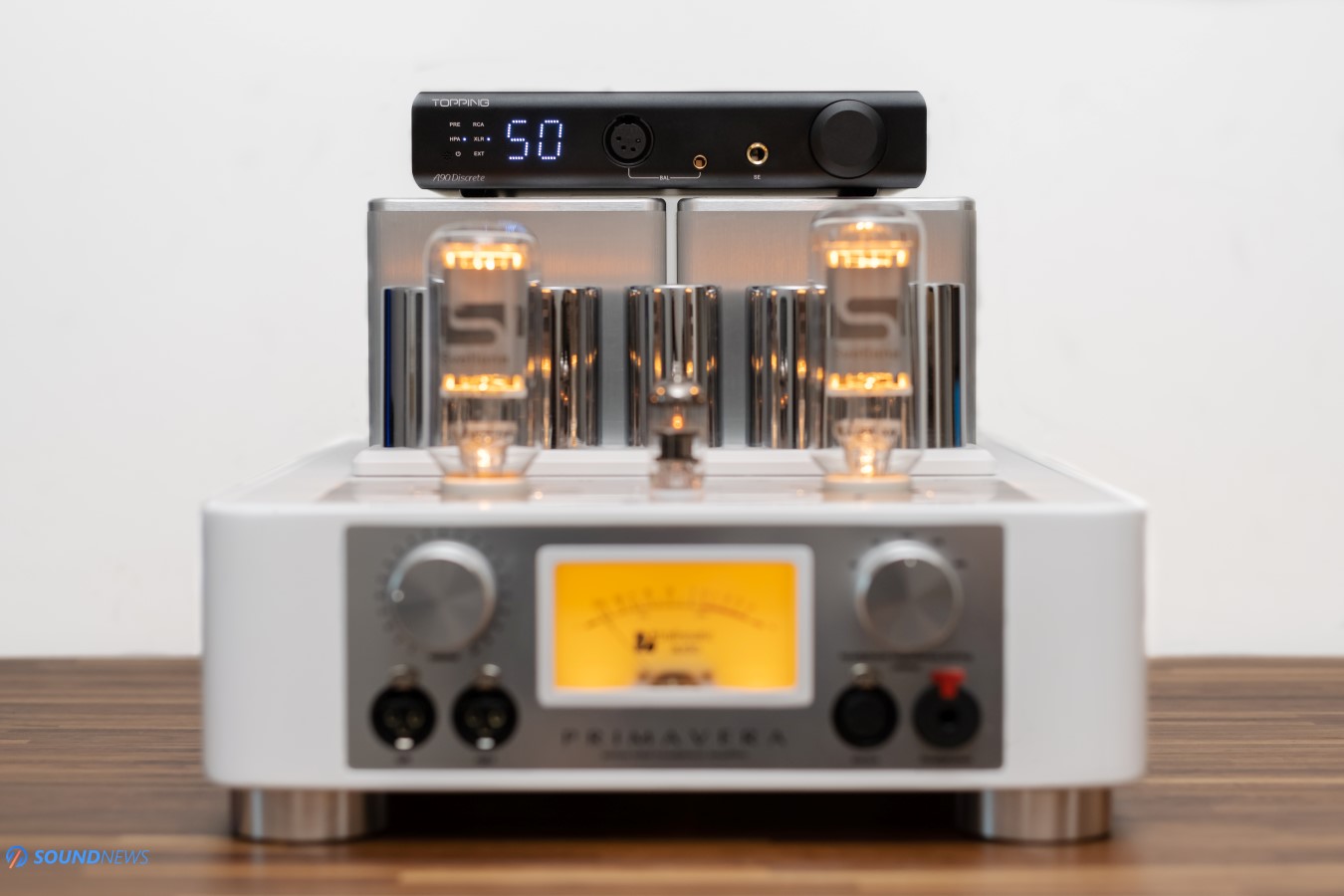
C. Treble
As the rest of the frequency response, treble sounds a little different. While mid-bass and the whole midrange region were elevated, improving the fun factor, the whole treble region took a 180 degree turn and lowered its intensity. The first born A90 was never bright or edgy sounding, with the wrong source or headphones…it could become like that. On the other hand, A90D handles bright DACs, headphones and recordings much better. Resolution and transparency didn’t take a hit and I feel that everything is located exactly where it should, there’s a lower pre and post ringing in the treble, less digitus if you will that makes everything easier to handle and by a whole lot more real sounding to me. When you go to a rock concert, no matter where you are located, you’ll never get bothered by the cymbals or double-drums playing loudly and I’m getting a similar effect via A90D. I’ve pushed that volume a little higher with a pair of Hifiman Susvara and I never wanted to lower the volume with such tunes. A90D offers a crispy treble that’s extended without becoming a burden, regardless of your headphones, source or source material.

VIII. Quibbles
If you’ll be using the regular 6.35mm (1/4”) headphone jack, then please update it to firmware 2.4 first, otherwise it will be turning off the moment you’ll be connecting or disconnecting your headphones. After the update it won’t do that so often, but…it might still turn off when disconnecting your cans. This issue wasn’t solved yet and I hope the next update will be the last one.
If you’ll be driving IEMs, then you’ll need to enable the Safe volume mode setting right away. For that, please turn it off completely with the switch on its back, press and hold on its volume wheel and while holding, turn the switch back to On position. Follow the instructions from the user manual and enable Safe volume mode, otherwise you can fry your IEMs or worse, permanently damage your hearing. I’m not sure why this setting wasn’t enabled by default. Still…even with safe volume mode enabled which essentially works as a slow start and slow turn off, you might get unpleasant pops when plugging and unplugging IEMs via the 6.35mm (1/4”) headphone jack. The 4-pin XLR and 4.4mm jacks are completely silent, but with the regular 6.35mm jack you won’t be as lucky. As I am typing this (on FW 2.4), A90D still turns itself off once in a while when disconnecting IEMs / headphones and sometimes there are loud pops when connecting and disconnecting sensitive IEMs. I do hope these issues will be solved in a future firmware update.

IX. A Mandatory Comparison
Topping A90 Discrete ($599) VS Topping A90 ($499)
I will skip all their specs, working principles and will focus my attention on their feature set and sound quality. First of all, let me remind you that a remote control and a relay-based volume control are major improvements that made A90D a strong candidate for the last preamp that you will ever need. It performs so well as a preamp, that it might cannibalize the Topping PRE90 sales, as these two are performing more or less the same, with the exception that I like the tuning of the A90D a little bit more. If you need an impressive headamp with outstanding preamp capabilities without breaking the bank, A90D is so far the highest recommendation I can give.
Gold Note DS-10 Plus already has a legendary active preamp stage which bypassed the need of an actual preamplifier. With all that said, DS-10 Plus still sounded tighter and clearer when I’ve added the A90D into the chain. Having a remote control feels like a big upgrade, as I no longer need to stand up and change the volume manually, as it’s the case with the regular A90.
That small, but clearly visible mini-LED screen is a huge life saver, as from my sofa I know exactly how much power is there left on tap. With A90 I needed to guess or approach it closely, a major inconvenient to say the least.
Lastly, its headamp section is a big departure from the old Topping sound. We are getting more power on tap, especially with low-impedance and low-sensitivity headphones. There is a better control of the drivers with planar-magnetics, a bigger headroom and of course – better dynamics. From a mediocre pairing with the Hifiman Susvara, the newest unit made them considerably jumpier and just…fun to listen to. A90D is still not an ultimate Hifiman Susvara amp, but it gets much closer to that description in comparison to the regular A90. Having more power on tap, you aren’t stressing the amplifier modules as much, getting less distortion in return. At moderate to high volume levels, I find A90D a little clearer and more transparent sounding. A90D offers a deeper and a slightly wider sound, getting a clearer overall picture when it comes to imaging. There is a mild improvement in the transient response department, as the newest unit can provide more oomph and rumble down low, including a better sustain of the bass notes. Last but not least, the whole frequency response moved from dead-neutral / ultra-linear to fun, colorful and natural sounding. As a direct result, the mid-bass feels stronger and the midrange carries a warmer tonality. Tunes like Night Train by Christian McBride (Qobuz / Tidal) are sounding considerably fuller bodied on the A90D as opposed to a flatter tonality of the regular A90. That cello sounded closer to what I would call as a life like performance. A90D moves more air, especially in the bass region, filling the gaps with more music, transforming tunes from linear to engaging. The only thing to remember is that you’ll need two to three days of burn-in until A90D enters its standard parameters, giving maximum performance. It will sound less engaging and full-bodied at first, but it will start blooming after just a few hours of use.
In the end, we are getting a much better volume control, a better preamp section, a display and a remote control. We are getting more power on tap, more current for low impedance planar, which tremendously improved their dynamics. All of this for just a $100 increase? I’ll have two A90D! Thank you.

My Conclusion
If there is a definition of a daily driver amp that works impressively well with movies, games and music, driving a wall of headphones starting from IEMs, portable over-ears, desktop dynamic and planar-magnetic headphones, then that’s surely the newest Topping A90D! If I’m overlooking a few quibbles that I experienced with IEMs via its single-ended headphone jack (which I’m sure will be solved with a future firmware update), then honestly, I have nothing else to complain about the A90D. Everything that I wanted A90 to be, was embodied in the A90D.
I’m glad that Topping acknowledged the limited nature of operational amplifiers (op-amps) and moved to an all-discrete circuity, which added so much more than raw power numbers. It sounded marvelous with all my headphones and it performed equally well in a high-end stereo setup. It worked better with my DAC collection, since it better managed the treble region versus its older sibling. Considering that I’m describing a $599 unit that does everything so well, it is my pleasure awarding it with my highest, Gold Award! It was fully deserved.

Topping A90 Discrete will set you off $599 and it was kindly provided by the fine gents of Apos Audio. It can be purchased from their web-store by following this link. (They still offer free shipping in the USA and Canada, free 45-day returns in case you don’t like it, an extra year of warranty and the lowest price guarantee). In case you’re getting one, please let me know in the comments section below how it performs in your headphone or stereo setup.
PROS:
- Sleeker looking than ever before, solid build quality
- Small footprint and is lightweight enough to be used in any setup
- Very powerful for its size, fully drove a wall of headphones
- Traded linearity with a much better tonal balance
- Richer, warmer and fuller sounding than any other Topping-made amplifier
- Super-extended at both ends of the spectrum
- Better dynamics with harder-to-drive headphones, there’s finally a fun factor on a Topping-made amplifier
- An improved transient response, especially when landing sub-bass notes
- Lacks any kind of noise or distortion even at max power, an IEM-friendly amp for sure
- Crazy levels of transparency and detail-retrieval
- Slightly wider and deeper sounding compared to their past doings could challenge even bigger and pricier amps
- Offers precise imaging and an outstanding layering
- Lacks glare and listening fatigue
- An outstanding value!
CONS:
- Its 6.35mm headphone jack is still buggy and quite annoying
- Doesn’t work with Topping’s RC22 metallic remote control
- At this price point…there aren’t additional cons, this is as good as it can get at less than a grand
ASSOCIATED EQUIPMENT:
- DACs: Chord Electronics Dave, Audiobyte HydraVox & HydraZap, Gold Note DS-10 Plus & PSU-10 Evo, Ferrum ERCO, Gustard R26 Discrete, Shanling EM7
- DDCs: Denafrips Gaia, Singxer SU-6
- DAPs: FiiO M17, M11 Plus ESS, M11S, Shanling M7, M6 Ultra, Hiby RS6
- Headphone Amps: Topping A90 Discrete, A90, Trafomatic Primavera, Trafomatic Head 2, Enleum AMP-23R, Burson Soloist 3X GT, Ferrum OOR + Hypsos, Flux Lab Acoustics Volot
- Preamps: Chord Electronics Ultima 3 Pre
- Power Amps: Chord Electronics Ultima 5, Burson Timekeeper 3X GT
- Loudspeakers: KEF Reference 3, Sound of Eden Crescendo UNO
- IEMs: FiiO FH9, FA9, FH7, FD7, Meze Rai Penta, LittleDot Cu KIS, Hiby Crystal 6, 7Hz Timeless, Kinera Skuld & others
- Full-sized headphones: Hifiman Susvara, Hifiman HE1000SE, Audeze LCD-5, Audeze LCD-4, Meze Elite, Sennheiser HD800S, Erzetich Phobos V2021, Erzetich Mania, Kennerton Rognir Planar, Vali, Apos Caspian, Sendy Peacock, Apollo, HarmonicDyne Poseidon & others
- Interconnects: QED Reference (x2), Topping TCX1 (x2)
- USB Cables: Supra USB Excalibur (x2), Chord C-USB, Matrix Hi-Fi USB
- HDMI Cables: Supra 8K HDMI 2.1 (x2)
- Speaker cables: Kimber PR8, Audioquest Type4
- Power Cables: Isotek EVO3 Premier (x3), iFi Audio SupaNova (x2)
- Balanced Isolation Power Conditioners: PLiXiR Elite BAC1500 (stereo setup), Elite BAC400 (headphone setup)


